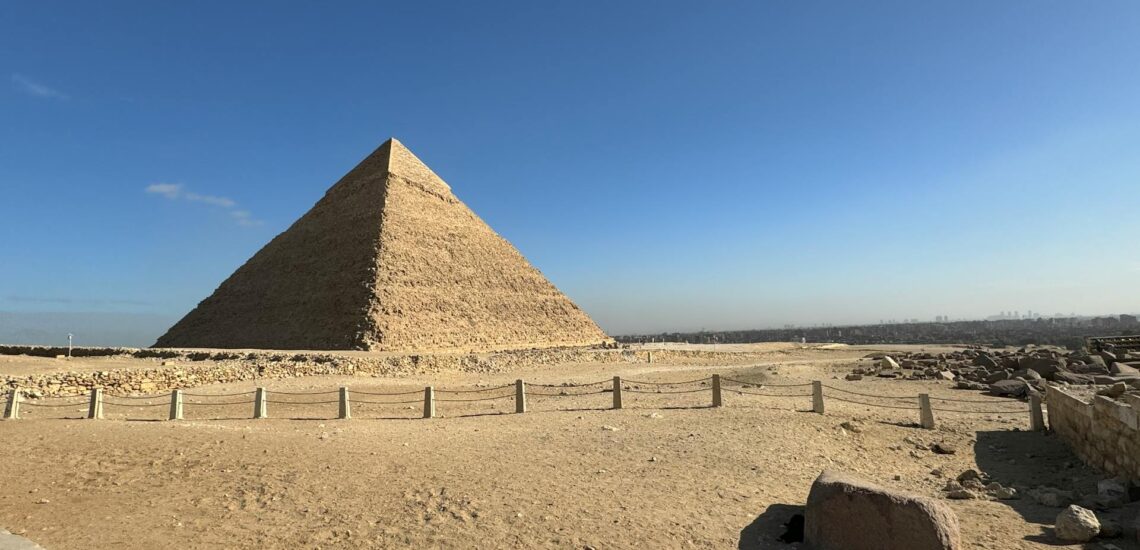Quick facts about Egypt:
- Population: Approximately 104 million people.
- Capital: Cairo.
- Largest City: Cairo.
- Official Language: Arabic.
- Other Languages: Egyptian Arabic, English, and French are also widely spoken.
- Currency: Egyptian Pound (EGP).
- Government: Unitary semi-presidential republic.
- Major Religion: Islam, predominantly Sunni.
- Geography: Located in North Africa, Egypt is bordered by the Mediterranean Sea to the north, Israel and the Gaza Strip to the northeast, the Red Sea to the east, Sudan to the south, and Libya to the west.
Fact 1: The Egyptian pyramids are the only surviving of the 7 Wonders of the World
The Egyptian pyramids, specifically the Great Pyramid of Giza, are the only surviving structures from the original Seven Wonders of the Ancient World. Built over 4,500 years ago during the reign of Pharaoh Khufu, the Great Pyramid is a testament to ancient Egyptian engineering and monumental architecture.
The Seven Wonders of the Ancient World were a list of remarkable constructions from the classical era, compiled by various Greek writers. These marvels were celebrated for their architectural and artistic achievements, reflecting the cultural and technological prowess of their respective civilizations. Here’s a brief overview of each:
- Great Pyramid of Giza, Egypt: The oldest and largest of the pyramids at Giza, built as a tomb for the Pharaoh Khufu around 2560 BCE. It is notable for its massive size and precise alignment with the cardinal directions.
- Hanging Gardens of Babylon, Iraq: Described as a terraced garden oasis with lush vegetation, supposedly built by King Nebuchadnezzar II around 600 BCE. Its existence and location remain debated among historians.
- Statue of Zeus at Olympia, Greece: A gigantic seated statue of the god Zeus, created by the sculptor Phidias around 435 BCE. It was housed in the Temple of Zeus in Olympia, renowned for its artistic grandeur.
- Temple of Artemis at Ephesus, Turkey: A large Greek temple dedicated to the goddess Artemis, rebuilt several times before its final destruction in 401 CE. It was known for its imposing size and elaborate decorations.
- Mausoleum at Halicarnassus, Turkey: A monumental tomb built for Mausolus, a satrap of the Persian Empire, and his wife Artemisia around 350 BCE. It was adorned with intricate sculptures and reliefs.
- Colossus of Rhodes, Greece: A giant bronze statue of the sun god Helios, erected at the harbor of Rhodes around 280 BCE. It was approximately 33 meters tall and was one of the tallest statues of the ancient world.
- Lighthouse of Alexandria, Egypt: Also known as the Pharos of Alexandria, it was a towering lighthouse built on the island of Pharos around 280 BCE. It served as a beacon for sailors entering the busy port of Alexandria and was admired for its innovative construction.
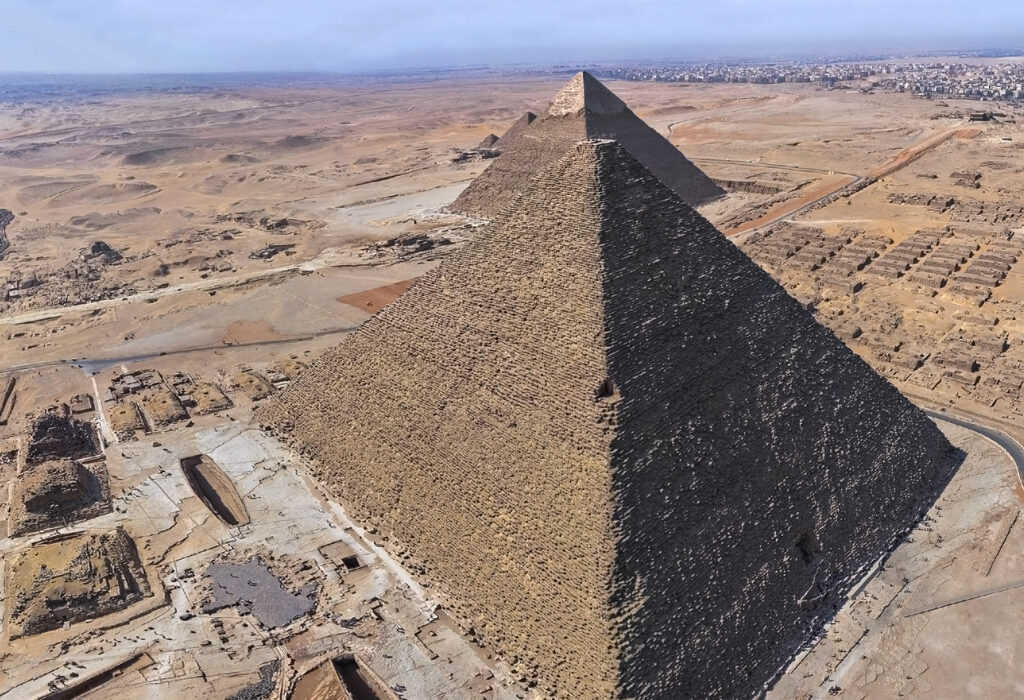
Fact 2: Almost the entire population of Egypt lives near the Nile River
The Nile River is not just a geographic feature but a lifeline for Egypt, shaping the country’s demographics and daily life. Almost the entire population of Egypt lives clustered along the Nile’s fertile banks and delta. This concentration is driven by the river’s unique ability to sustain agriculture through its annual flooding, which deposits nutrient-rich silt across the Nile Valley and Delta. This fertile land supports the cultivation of crops like wheat, barley, and cotton, crucial for both sustenance and export.
Beyond agriculture, the Nile provides essential freshwater for drinking, irrigation, and industrial use in an otherwise arid landscape. This dependency has historically dictated settlement patterns and economic activities, fostering the growth of cities and towns along its course. Urban centers such as Cairo, Luxor, and Aswan have thrived as hubs of commerce, culture, and administration, linked by transportation networks that follow the river’s path.
Fact 3: The Suez Canal in Egypt is a major transportation route
This artificial waterway, completed in 1869, plays a pivotal role in global trade by significantly reducing travel time and distance for ships navigating between the Atlantic and Pacific Oceans.
Strategically located at the crossroads of Europe, Africa, and Asia, the Suez Canal is vital for international shipping, allowing vessels to avoid the lengthy and hazardous journey around the southern tip of Africa, known as the Cape of Good Hope. Annually, thousands of cargo ships, container vessels, tankers, and other maritime vessels traverse the canal, carrying goods ranging from crude oil and natural gas to manufactured products and raw materials.
The canal’s importance extends beyond commercial interests, serving as a linchpin for regional economies and global supply chains. It generates significant revenue for Egypt through toll fees and supports related industries and infrastructure development along its corridor. Moreover, the Suez Canal’s strategic significance has made it a focal point for international diplomacy and cooperation among nations reliant on its efficient operation.
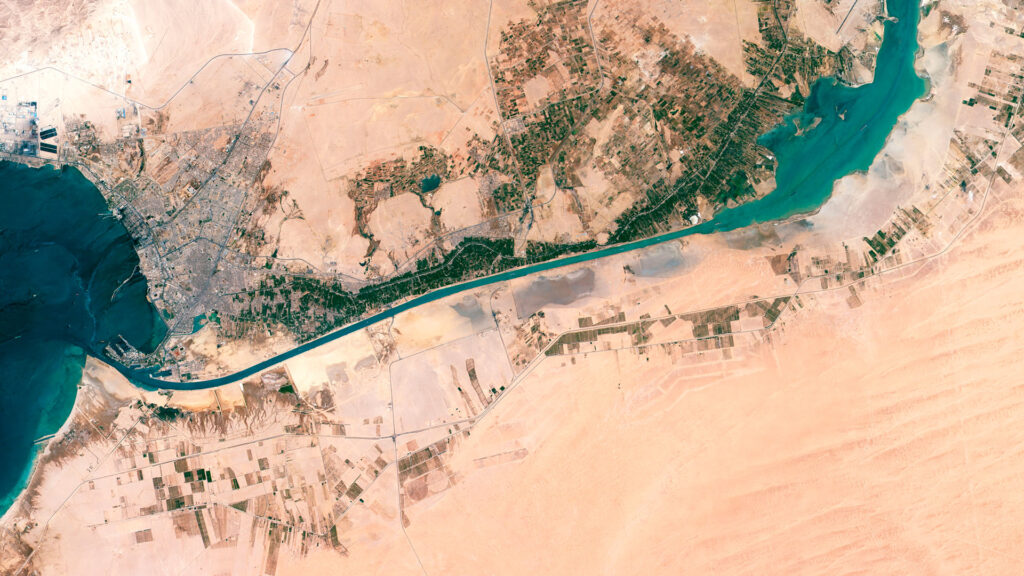
Fact 4: Cleopatra wasn’t Egyptian
She was a member of the Ptolemaic dynasty, which ruled Egypt after the death of Alexander the Great. The Ptolemies were of Macedonian Greek origin and maintained their Greek identity and traditions despite ruling Egypt.
Cleopatra’s family, including her father Ptolemy XII Auletes and her predecessors, were descendants of Ptolemy I Soter, one of Alexander the Great’s generals who became the ruler of Egypt in the aftermath of Alexander’s conquests. Throughout the Ptolemaic period, the ruling class in Egypt, including the royal family and administrators, predominantly spoke Greek and adhered to Greek customs and traditions.
Despite her Greek ancestry, Cleopatra embraced Egyptian culture and religious beliefs to strengthen her position as the pharaoh of Egypt. She learned the Egyptian language and portrayed herself as the reincarnation of the Egyptian goddess Isis, which endeared her to the Egyptian people. Cleopatra’s alliance with Julius Caesar and later Mark Antony was pivotal in the political and military struggles of the Roman Republic and the subsequent Roman Empire.
Fact 5: Egypt has preserved a huge number of historical monuments
Egypt boasts an impressive number of historical monuments, with over 100 pyramids scattered across the country, the most famous being the Great Pyramid of Giza. The ancient temples along the Nile River include well-preserved sites such as Karnak Temple Complex in Luxor, which covers about 200 acres and is one of the largest temple complexes in the world. Additionally, Egypt is home to numerous tombs in the Valley of the Kings, where over 60 tombs have been discovered, including the famous tomb of Tutankhamun.
Preserving these monuments is a monumental task in itself, with ongoing efforts by Egyptian authorities and international organizations. The restoration and conservation of these ancient structures are crucial for maintaining their integrity and ensuring they continue to educate and inspire future generations about Egypt’s rich history and cultural heritage. These efforts also support Egypt’s tourism industry, which relies heavily on visitors coming to explore these iconic landmarks and archaeological sites.
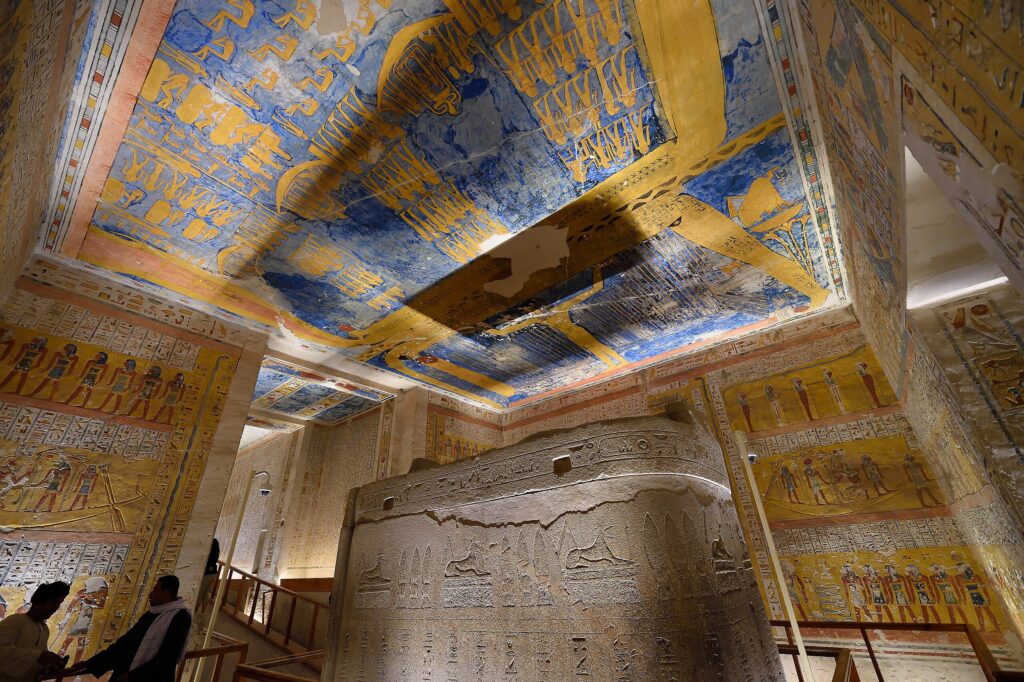
Fact 6: A large number of artifacts were taken out of Egypt during the colonial period
This period, particularly from the 19th century onwards, saw extensive excavation and collection of ancient Egyptian artifacts by European archaeologists, collectors, and explorers.
The influx of foreign archaeologists and treasure hunters was fueled by a fascination with ancient Egyptian culture and the desire to unearth valuable artifacts. Many of these artifacts, including statues, pottery, jewelry, and sarcophagi, were taken out of Egypt and ended up in museums and private collections around the world.
The most notable example is the Rosetta Stone, discovered in 1799 by French soldiers during Napoleon Bonaparte’s campaign in Egypt. This artifact, crucial for deciphering ancient Egyptian hieroglyphs, was later acquired by the British Museum in London.
In more recent decades, Egypt has made concerted efforts to repatriate looted artifacts through diplomatic negotiations and legal means, reclaiming some items from international museums and institutions.
Fact 7: The Egyptians had thousands of gods
Ancient Egyptians had a complex and diverse pantheon, with thousands of gods and goddesses representing various aspects of life, nature, and the cosmos. These deities ranged from major gods like Ra, the sun god, and Osiris, the god of the afterlife, to minor gods associated with specific functions or local cults. Each deity played a distinct role in Egyptian mythology and religious practices, influencing daily life, rituals, and beliefs.
Also cats held a particularly significant place in ancient Egyptian society and religion. They were revered for their grace, beauty, and perceived protective qualities. The goddess Bastet, often depicted as a lioness or with the head of a domestic cat, was the patroness of home, fertility, and childbirth. Cats were considered sacred to Bastet, and their presence in households was believed to bring blessings and ward off evil spirits.
The importance of cats extended beyond religious symbolism. They were valued as protectors of crops and granaries, keeping rodents and pests at bay.
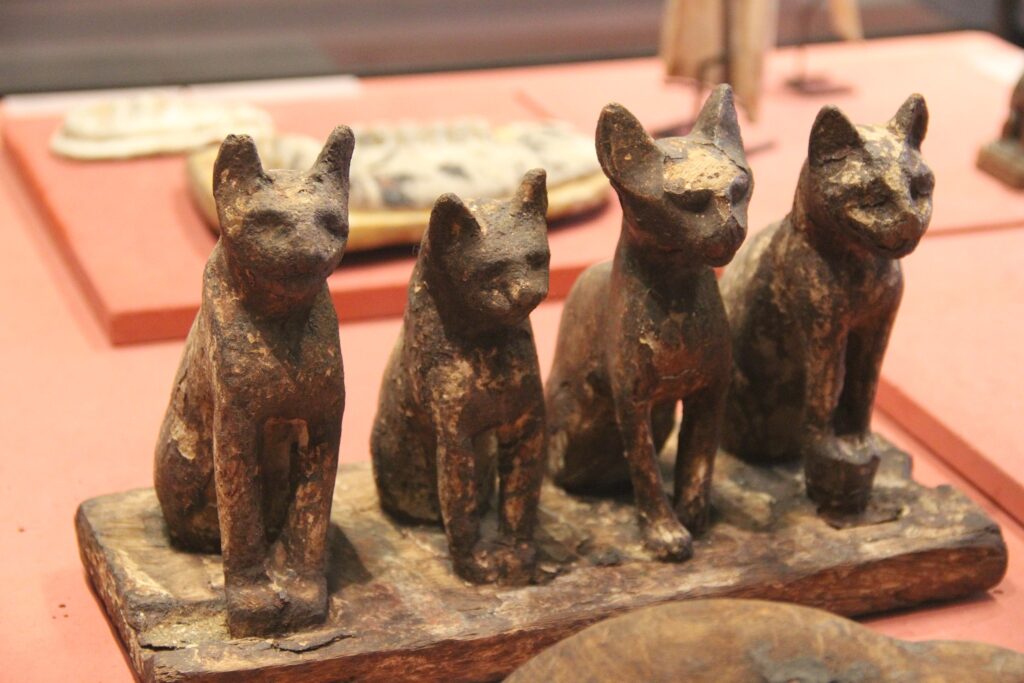
Fact 8: Geographically, Egypt is located on two continents
Geographically, Egypt is situated in northeastern Africa and spans across the northeastern corner of the African continent and the southwestern corner of the Asian continent. The country is bounded by the Mediterranean Sea to the north, the Red Sea to the east, Sudan to the south, and Libya to the west. The Sinai Peninsula, located in the northeastern part of Egypt, connects the African mainland to the Asian continent.
Fact 9: Egypt has 7 UNESCO World Heritage Sites
Egypt is home to seven UNESCO World Heritage Sites, each recognized for their outstanding cultural or natural significance. These sites showcase Egypt’s diverse heritage and include:
- Ancient Thebes with its Necropolis (Luxor): This site includes the ruins of the ancient city of Thebes (modern-day Luxor), including the temples of Karnak and Luxor, the Valley of the Kings, and the Valley of the Queens.
- Historic Cairo: The heart of Cairo, Egypt’s capital, is recognized for its Islamic architecture, including mosques, madrasas, and other historic buildings.
- Abu Mena: This archaeological site features the remains of a Coptic Christian monastic complex and pilgrimage center, located near Alexandria.
- Nubian Monuments from Abu Simbel to Philae: This site includes the temples of Abu Simbel, constructed by Ramses II, and the temples of Philae, which were relocated due to the construction of the Aswan High Dam.
- Saint Catherine Area: Located in the Sinai Peninsula, this site includes Mount Sinai, where according to tradition, Moses received the Ten Commandments, and the Monastery of Saint Catherine, one of the oldest Christian monasteries in the world.
- Wadi Al-Hitan (Whale Valley): Known for its fossilized remains of extinct whales and other marine life, Wadi Al-Hitan is a desert area southwest of Cairo and provides insights into the evolution of whales.
- The Ancient City of Qalhat: Located in Oman, this site includes the remnants of an ancient city and port that was once an important trade hub between the 11th and 15th centuries, with strong cultural ties to Egypt.
Note: If you are planning to travel independently in the country, check if you need an International Driving License in Egypt to rent and drive a car.

Fact 10: Egypt’s population structure changed dramatically after the Arab conquest
The Arab conquest of Egypt in the 7th century CE brought significant demographic and cultural changes. Arab settlers and soldiers migrated into Egypt, leading to the spread of Arabic language, Islamic faith, and cultural practices. Urban centers like Cairo flourished as hubs of commerce and Islamic learning. Despite these changes, indigenous Egyptian communities, such as Coptic Christians, maintained their cultural and religious identities alongside the new Arab-Islamic influences. This period laid the foundation for Egypt’s diverse cultural heritage and modern identity.

Published June 30, 2024 • 10m to read

